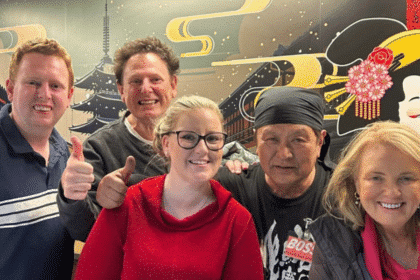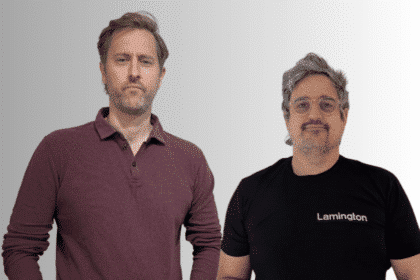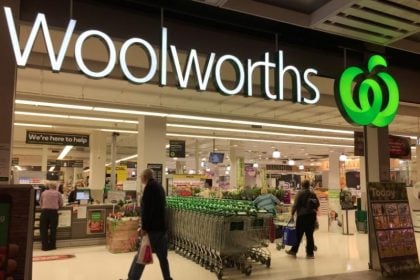It’s rare that trade journalists get such unfettered access to the country’s leading marketers as B&T’s hacks do when we’re putting together the CMO Power List, presented this year by atn.
From hair and makeup to outfit changes, the actual photographic session, and the formal sit-down interview (all at the Made In Katana studio), we can sit next to the holders of the biggest purses in Adland for hours. In fact, some of the interviews alone have been known to exceed well over an hour and a half.
That’s why we’re not letting the 550-ish-word writeups in the formal Power List do all the talking. Instead, we’ll be analysing and highlighting the key nuggets that everyone needs to hear from these most eminent marketers.
For this first piece, we’re going to be looking at agency reviews–yes, the most reliable of column-inch-filling topics. We’ve got big reviews, small(er) reviews and even some controversial pitches.
Droga5 and Accenture Song Ride Off
Two of the most significant wins in recent times came from the Droga5 (then The Monkeys) and the Accenture Song teams. In March last year (yes, we published 2024’s CMO Power List in February last year) the team picked up the creative account for IAG’s NRMA Insurance–as well as the larger piece of work transforming its customer experience.
Then in July, the team won the highly coveted Tourism Australia creative account from M&C Saatchi.
Accenture Song’s mixture of global scale but local knowledge certainly seems to have played a part in both appointments.
“We really liked the idea of having this global/local team,” said Michelle Klein, CMO of NRMA Insurance parent IAG.

“In principle, it seemed like a great idea but in practice, it was awkward because of the New York and Sydney time zones. But we figured out a really good rhythm where David [Droga], Nick Law and others would be online in the States and Barb Humphreys and her team over here. The way they work is really interesting. They create this sort of cross-global, cross-country team. But everyone understands the brand and, for the most part, everyone is Australian,” said Klein, despite its global/local approach.
“If you’ve got the willingness to make something work and people who are passionate, they’ll look how they need to make it work and we’ve seen it come through. The teams have been super-energised from working with the other parts of Song, as well.”
Susan Coghill, CMO of Tourism Australia, explained that the decision to dispense with M&C Saatchi came from a “really robust” tender process. It had been known as one of the most hotly contested pitches in recent times with the incumbents partnering with Howatson+Company for a new solution, Publicis Groupe rumoured to be in the fight and Clemenger Group.
“There are really four things that landed for us very strongly: the strategic approach for our brand, for our advertising because they really did pull those two components apart and look at it for us. But then also the digital challenge we gave them of ‘Where to next?’ for destination marketing organisations’ websites. They hit the nail on the head for those three components of the brief,” she explained.

“Their interpretation of ‘Come and Say G’Day’ and Ruby [the Roo] as a creative idea, their embracing of the platform and the fact that they understood the importance of consistency and building those brand codes, that we needed the multiplier effect of being able to run a campaign over time and over geographies was really important.”
But there was more, Coghill said that Accenture Song and Droga5’s integration of indigenous cultures into their ideas was “probably” the best on show.
“Lastly, they have a very unique proposition around bringing the best of Australian creative talent around the world to bear on our business. That is something that has come out in every meeting so far and the entire creative development process.”
It’s fascinating to see two very, very different brands in very different categories be so enthralled with the idea of Aussie-ness and the mix of local and global talent–though with an Aussie flavour.
GroupM’s Impressive Wins
Over the space of four months in 2024 GroupM’s agencies added more than $100 million in client billings to its coffers.
First GroupM’s OpenMind solution, which pulls in bits from all the GroupM agencies but is centred around Mindshare, won the AU$55 million-rated Nestlé account from incumbent UM as well as a rival bid from Publicis.
Then in April, EssenceMediacom won the Specsavers pitch–worth just shy of AU$50 million, according to COMvergence.
“Fundamentally why we were pitching is because we wanted connected technology,” said Douglass.

“There is such an opportunity to drive efficiencies in that area, particularly for our marketers and our agencies… The other reason that we pitched was to find the people–because agencies are all about people–who are strategically aligned with our view from an FMCG planning perspective.”
Nestlé’s main creative agencies are VML and Ogilvy–both owned by WPP, which owns GroupM and, by extension, OpenMind and Mindshare. Douglass described the joint ownership as an “additional benefit.” It still employs Saatchi & Saatchi for its coffee brands.
“It allows you to have more open conversations,” said Douglass, “and when it comes to creativity of thinking, it allows both the media agency and the creative agency to bounce off one another. But the same thing does and should happen with Saatchis.”
The Specsavers pitch, however, run by director of marketing planning Shaun Briggs was different and raised eyebrows within the industry.
The pitch started with an open RFI that any agency—in theory, at least—could take part in. It’s been reported that some 50 agencies submitted proposals to the first round where they could demonstrate their capabilities.
“It raised eyebrows for me, too, because we had more submissions than I was expecting,” said Briggs.

“Honestly, and probably somewhat naively, I thought the maximum we’d get would be 20. If you answered all the questions, and there weren’t that many questions, I felt there’s probably 20 that could do it. Some of them would be coalitions of indies and the holdcos. But what we actually got was a whole bunch of agencies who opened the one of the early questions around could you manage a client of this scale and size? And they were like, ‘no’. So why are you doing this?”
Briggs added that a number of agencies submitted in order to “get on [Specsavers’] radar” and specialised in particular areas. Briggs said he has kept these submissions on file, just in case the need arises.
This was then whittled down to 10 for chemistry sessions, with one agency dropping out midway through a chemistry session. These agencies were then asked to complete a 48-hour mock brief, unusually short for pitches, but not unreasonable in the real world.
The process divided people. Some agencies, including some of those that made the chemistry sessions but were ultimately unsuccessful, have publicly lauded the pitch. Others, including some pitch consultants, have been highly critical.
“No doubt it was different from what people expected,” Briggs, who has served in senior roles at Initiative, Dentsu Mitchell and Mediaccom, told B&T.
“With any decision you make, you’ve got to be clear what you’re actually wanting out of it. Having been on the other side of it many, many, many times, I’m not sure every client that I’ve worked on a pitch for really did know what they wanted—partly because I don’t think they really understood what media agencies really do. I’m not trying to be critical but I didn’t see depth and detail of people who really knew. I felt like I did.”
Briggs added that he felt incumbent Initiative was a “really good” agency. He added that he believed the large Specsavers marketing team had to feel confident they could work with the new agency.
“I wanted my team to feel the same way about your day-to-day team. Let’s make this the most real environment as you possibly can in a pitch,” he said.
If he’d given the agencies “six-to-eight” weeks to turn around a presentation, it wouldn’t be reflective of the real world.”
Briggs said in hindsight, he’d have added slightly more commercial stuff upfront, but again, his experience on the side of the ledger meant he had a good idea of the costs.
Would the pitch work for every client? Probably not. But it worked for Specsavers, with its longstanding ‘Should’ve’ platform and need for smart media activations. But regardless, it stands as a marked difference between some of the aforementioned pitches where agency groups were flying the top brass around the world. Is it better? It’s hard to say. It certainly isn’t worse.
Agency Villages
As traditional full-service agencies split down specialised lines, the need for agency village models grew with different agencies with different specialisms working, hopefully, hand-in-hand together.
In January, McDonald’s, led by SVP and chief customer officer, Chris Brown, became the first Australian client to add Wieden + Kennedy to its roster, which also features DDB and Akcelo, as well as media partner OMD.

We say first because, while the Wieden team has said it’s fully committed to its current Macca’s remit of chicken and coffee—we can’t see it staying that way forever.
BUPA’s Naomi Driver, meanwhile, announced that it had dispensed with Thinkerbell’s services as its creative agency, plugging in an agency village model led by CHEP Network with support agencies including 2045, Six Black Pens and Scooter. Now, however, CHEP has been swallowed by Clemenger. How that shakes out remains to be seen, B&T has contacted BUPA for comment on the changes—though we understand much is still very much up in the air at CHEP.
“We were really mindful that the breadth of services we needed at an enterprise level was quite broad. So this was an initiative around bringing all of the marketing areas together for the first time to start aligning what those creative needs were so we would have an agency village that could be utilised by the entire enterprise business,” Driver told B&T.

“We’ve got a mix because we had a very defined brief around what we needed to deliver with our broader healthcare aspirations. It wasn’t a pitch where we knew the outcome from the get-go. We understood the needs of the business and went through a very transparent process with existing partners and new what we needed in terms of the pieces of the puzzle to create the right village.”
However, while Macca’s and BUPA have expanded their agency models, Suncorp went the other way. Its CMO Mim Haysom consolidated its nine insurance brands under Publicis’ Leo Burnett, incumbent creative agency on the main Suncorp brand. WPP’s Ogilvy had run the creative for AAMI. The move was decided following a four-way pitch between WPP, Publicis, BMF and The Hallway. Publicis’ PXP and Prodigious arms also now run centralised creative production, taking over from WPP’s Hogarth.
“Our business went through significant change in the last six months with the divestment and sale of Suncorp Bank. There’s been a lot of focus on our strategy as a standalone pure-play insurer and, in the context of that change in the organisation, I felt the time was right to re-evaluate the agency model that we had. We explored a range of different models and co-designed with my team the model that we felt would be the most appropriate model for the future. We briefed a very select number of agencies,” said Haysom.

“We’re looking to drive a lot of technology and innovation. We’re looking to embed a lot of technology and innovation. We need to be more creative than ever before with our portfolio of brands to really drive growth.”
Haysom said Leos offered the “total package”.
“It was great creative, a great agency model, strong strategy and a great cultural fit.”
What comes next?
We’ll have to wait and see. B&T understands that there are a significant number of high-profile pitches underway, including the widely reported Optus media and creative contests.
Check back in with next year’s CMO Power List to find out what’s what—and perhaps more importantly, who’s who—in agency land.








